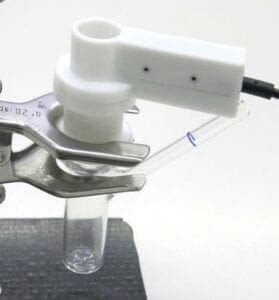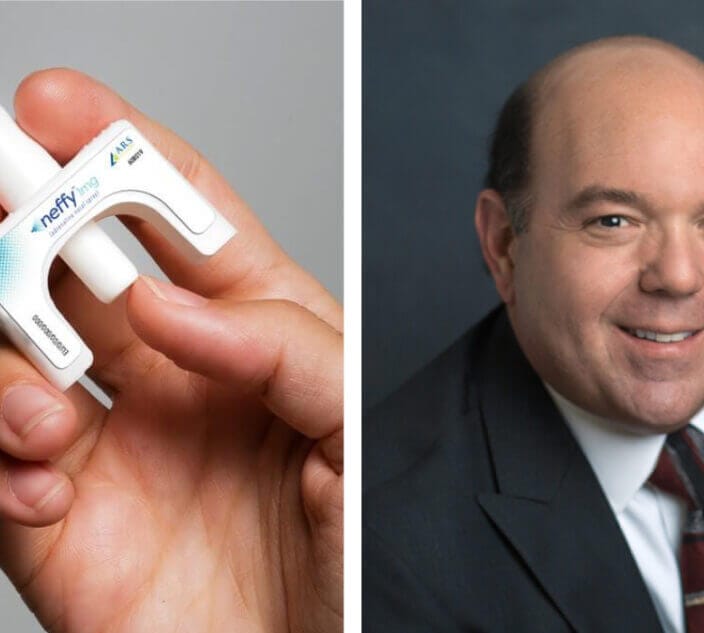Oral food challenges are a highly accurate way of confirming whether or not someone has a food allergy. But many people, including physicians, are reluctant to do food challenges because of the risk of severe allergic reactions.
Researchers from the University of Michigan may have come up with a way to predict who will have a severe reaction during an allergy challenge – well before symptoms become obvious. By measuring changes in the amount of water loss through the skin during the food challenge, researchers could tell who would go on to experience anaphylaxis. The results were apparent an average of 45 minutes before symptoms fully kicked in.
During oral food challenges, patients with suspected allergies start by eating a small amount of their allergen. They gradually progress through higher amounts of the food over the course of several hours.
Being able to detect impending reactions would allow doctors to end the challenge sooner, and at a lower dose, says Dr. Charles Schuler, assistant professor of allergy and clinical immunology at the university’s Mary H. Weiser Food Allergy Center.
“There is a huge need to make food challenges safer,” Schuler says. If the research pans out, “we could stop reactions before they are severe or obvious. This would make food challenges safer, yet still accurate, in telling you whether you are allergic or not.”
To test skin water loss as an indicator of anaphylaxis, Schuler and his colleagues conducted a study with a device called a Tewameter. It sits on the forearm and has 30 sensors that measure “transepidermal” water loss, or the amount of moisture evaporating through the skin.
A Tewameter is typically used in research to gauge “skin barrier integrity.” Intact skin loses less moisture than compromised skin. Since people with eczema often have skin barrier impairment, they tend to have higher water loss, while those with healthy skin have lower water loss, Schuler explains.
Water Loss as ‘Anaphylaxis Radar’
A high rate of water loss also occurs during allergic reactions, although the reasons aren’t fully understood, he says. One theory is that anaphylaxis causes blood vessels to become more permeable, and leak fluids.
The UMichigan study included 76 children ages 18 and under, with a variety of food allergies. Schuler and his team measured the amount of skin water loss before the start of a food challenge, and again during the challenge. They found that the water loss spiked in those who reacted during the challenge, whereas the rate of water loss didn’t change much for those who didn’t react.

“We found that transepidermal water loss rises substantially and significantly during food anaphylaxis,” Schuler says. “And that it rises before anaphylaxis is evident.”
Like “anaphylaxis radar,” the water loss spike was detected 45 minutes before symptoms became pronounced enough to be considered anaphylaxis. A separate group of 30 kids had their rate of skin moisture loss measured during the entire food challenge. A rise in skin water loss could be detected five minutes after the first dose of their allergen in those who reacted. A similar rise was not seen in those who passed the challenge.
Anaphylaxis was confirmed using a blood test that measures tryptase, an enzyme that is elevated after a severe allergic reaction. Continuous monitoring “predicts anaphylaxis with very high specificity,” the researcher adds.
Schuler’s team is presenting the research at the American Academy of Allergy, Asthma & Immunology annual meeting in San Antonio, Texas.
Test in Peanut-Allergic Kids

The Michigan researchers’ next step is a randomized trial with 40 peanut-allergic children ages 5 and under. The idea is to see whether continuously monitoring their skin water loss during a food challenge can help avoid anaphylaxis.
One group will undergo the challenge using a typical protocol. Physicians will monitor for symptoms of an allergic reaction, and will make decisions about halting or pressing on with the challenge based on that.
In the other group, physicians will use the water loss measurement to make decisions about when to stop dosing. The aim is to see if the water loss measurements result in fewer severe reactions.
The devices that are commercially available aren’t ideal for everyday use. If the approach turns out to be useful, Schuler and his team hope to adapt the device so that it could be more easily used in allergist’s offices, he adds.
“This may help both families and doctors feel more confident in doing food challenges,” Schuler adds.
Related Reading:
Update on Rewards, Risks of Baked Food Challenges for Milk and Egg Allergies
Allergy Mom’s Take: Oral Food Challenges Are Worth the Stress





